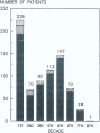Experience with primary liver transplantation across ABO blood groups
- PMID: 3321622
- PMCID: PMC2911142
Experience with primary liver transplantation across ABO blood groups
Figures

 , Identical;
, Identical;  , GVH;
, GVH;  , incompatible.
, incompatible.
 , incompatible;
, incompatible;  , GVH;
, GVH;  , ABO identical.
, ABO identical.
 , ABO identical;
, ABO identical;  , GVH;
, GVH;  , incompatible.
, incompatible.

 , functioning;
, functioning;  , retransplanted;
, retransplanted;  , died.
, died.

 , stable;
, stable;  , urgent.
, urgent.References
-
- Gordon RD, Iwatsuki S, Esquivel CO, et al. Surgery. 1986;100:342. - PubMed
Publication types
MeSH terms
Substances
Grants and funding
LinkOut - more resources
Full Text Sources
Medical
